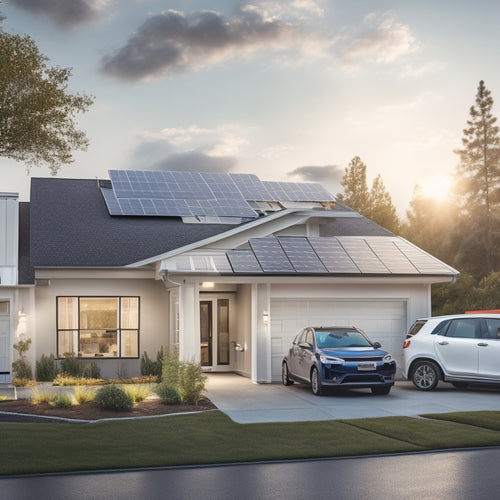
High Efficiency Solar Panel System Optimization
Share
You're seeking to optimize your high-efficiency solar panel system to maximize energy production, and that requires a thorough approach that considers every detail, from panel angle and orientation to advanced inverter technology and real-time performance monitoring. Strategic panel placement, seasonal adjustments, and continuous sunlight exposure evaluation can greatly enhance energy capture. Additionally, advanced inverter technology integration and energy loss mitigation strategies, such as temperature management and high-quality material selection, can further improve efficiency. By adopting these measures and staying on top of performance tracking, maintenance, and shading mitigation, you'll be well on your way to revealing the full potential of your solar panel system – and there's even more to investigate to take your system to the next level.
Key Takeaways
- Strategic orientation and positioning of solar panels, including seasonal adjustments, enhance energy capture and maximize energy production.
- Advanced inverter technology improves grid connection efficiency, minimizes connection losses, and enhances overall system efficiency.
- Temperature management techniques, such as shading, and high-quality materials mitigate energy losses and ensure durability against environmental stressors.
- Real-time performance tracking and predictive analytics identify areas for improvement, detect faults proactively, and optimize energy output.
- Regular maintenance scheduling, including cleaning, inspections, and performance analysis, ensures optimal system performance, longevity, and minimizes energy losses.
Maximizing Energy Harvest Potential
By strategically orienting and positioning solar panels, you can maximize energy harvest potential. This involves optimizing panel efficiency by adjusting the angle and direction of the panels to capture the most sunlight throughout the day.
Seasonal adjustments are also essential, as the sun's path changes throughout the year. During the summer months, the sun is higher in the sky, so panels should be adjusted to a more vertical angle to maximize energy production. In the winter, the sun is lower, and panels should be adjusted to a more horizontal angle to capture as much sunlight as possible.
Additionally, you should consider the surrounding environment when positioning your solar panels. Shading from trees, buildings, or other obstructions can greatly reduce energy production.
Identifying Optimal Panel Angles
Maximizing solar panel angle is critical to enhancing energy harvest potential. You need to evaluate various factors to determine the ideal angle for your solar panel system. Seasonal adjustments, geographic considerations, and installation orientation are key factors that influence energy production.
| Factor | Maximization Evaluation |
|---|---|
| Geographic Location | Latitude, longitude, and altitude affect sun's path, influencing ideal angle |
| Structural Compatibility | Roof pitch, material, and obstructions impact installation orientation and angle |
| Weather Impact | Local weather patterns, such as shading, wind, and snow, influence tilt maximization |
| Local Regulations | Compliance with local building codes and regulations affects angle calculation and installation |
You'll need to conduct a thorough site assessment to determine the ideal angle for your solar panel system. This involves analyzing your location's solar irradiance, local weather patterns, and structural constraints. By evaluating these factors, you can maximize your solar panel angle to enhance energy production. Additionally, incorporating tracking systems can further improve energy harvest potential.
Advanced Inverter Technology Integration
You'll want to utilize advanced inverter technology to optimize your solar panel system's performance.
This integration enables you to improve grid connection efficiency, ensuring a seamless transfer of energy to the grid.
Grid Connection Efficiency
As solar panel systems increasingly interact with the grid, advanced inverter technology integration becomes essential for achieving high grid connection efficiency. You need to verify that your system can effectively synchronize with the grid frequency and voltage to maximize power output. This is where grid connection efficiency comes into play.
Advanced inverter technology integration helps minimize connection losses, which can notably reduce your system's overall efficiency. By optimizing grid connection efficiency, you can reduce the losses associated with converting DC power from your solar panels to AC power for the grid. This results in more power being fed into the grid and increased revenue for you.
Furthermore, high grid connection efficiency is critical for maintaining grid stability, which is essential for guaranteeing a reliable and efficient distribution of power. By leveraging advanced inverter technology integration, you can secure a stable and efficient grid connection, ultimately leading to increased energy harvest and revenue.
Power Quality Enhancement
With the grid connection efficiency of your solar panel system optimized, it's essential to focus on power quality enhancement through advanced inverter technology integration.
You need to guarantee that your system provides a high-quality power output that meets the grid's requirements. Advanced inverters play a vital role in achieving this by regulating voltage, frequency, and power factor.
They also minimize harmonic distortion, assuring that your system's output is clean and stable.
Real-Time Monitoring
Your solar panel system's real-time monitoring capabilities are greatly enhanced through advanced inverter technology integration, allowing you to track its performance and identify potential issues promptly. This integration enables you to make data-driven decisions, guaranteeing ideal system performance and minimizing downtime.
| Feature | Description | Benefits |
|---|---|---|
| Data Visualization | Graphical representation of system performance data | Quick identification of trends and anomalies |
| Performance Alerts | Real-time notifications of system issues | Prompt response to potential problems |
| Predictive Analytics | Advanced analysis of system data to predict potential issues | Proactive maintenance and reduced downtime |
With advanced inverter technology, you can access your system's performance data remotely through a user-friendly interface, allowing you to monitor your system from anywhere, at any time. Sensor deployment and system integration enable real-time data collection, which is stored in the cloud for historical comparison and analysis. Additionally, mobile access and remote diagnostics capabilities enable you to troubleshoot issues quickly and efficiently, reducing the need for on-site visits. This advanced monitoring system guarantees that your solar panel system operates at peak performance, maximizing energy production and reducing maintenance costs.
Energy Loss Minimization Strategies
Optimizing a solar panel system's energy output requires a thorough understanding of energy loss minimization strategies. You need to identify and address inefficiencies in your system to maximize its performance.
One key strategy is temperature management, as high temperatures can reduce energy output. You can use techniques like shading or cooling systems to mitigate this effect.
Another important aspect is material durability. Using high-quality materials that can withstand environmental stressors like weathering and corrosion is essential. Additionally, considering the environmental impact of your system is significant. You should choose materials with minimal environmental footprint and guarantee responsible waste disposal.
System scalability and installation techniques also play a significant role in minimizing energy losses. You should design your system to be scalable and adaptable to changing energy demands. Proper installation techniques can also reduce energy losses by guaranteeing the best panel angles and orientations.
Real-Time Performance Monitoring
You can optimize your solar panel system's performance by tracking its real-time operation and analyzing its energy output.
This involves monitoring key performance indicators, such as voltage, current, and power output, to identify potential issues and opportunities for improvement.
System Performance Tracking
The real-time performance monitoring of a solar panel system is vital to guaranteeing ideal energy production. You need to track your system's performance in real-time to identify areas of improvement and enhance energy output. This is where system performance tracking comes in.
By logging data on your system's performance metrics, such as energy output, temperature, and voltage, you can identify trends and patterns that may indicate potential issues. System calibration is also important to confirm that your system is operating within optimal parameters.
Through software integration, you can utilize predictive analytics to forecast energy production and detect potential faults before they occur. This enables proactive maintenance and minimizes downtime.
With remote access, you can monitor your system's performance from anywhere, engaging with your system in real-time. By analyzing trends and comparing them to performance benchmarks, you can refine your system's performance and maximize energy production.
Effective system performance tracking is essential to squeezing every last watt out of your solar panel system.
Energy Output Analysis
Real-time energy output analysis is the heartbeat of system performance tracking, providing instantaneous understanding into your solar panel system's productivity.
This critical component of system optimization enables you to monitor your system's energy output in real-time, identifying areas of improvement and opportunities for optimization.
To get the most out of your energy output analysis, consider the following key factors:
-
Solar irradiance factors: Understand how varying levels of solar irradiance impact your system's energy output.
-
Seasonal performance variations: Analyze how seasonal changes affect your system's energy output and adjust your strategy accordingly.
-
Installation location impact: Assess how your installation location influences your system's energy output and identify opportunities for improvement.
Shading Mitigation Techniques Applied
Across various solar panel installations, shading remains a pervasive issue, greatly diminishing energy output. To alleviate this, you'll need to employ effective shading analysis techniques. This involves identifying potential shading sources, such as nearby buildings, trees, or structures, and evaluating their impact on your solar panel system.
By conducting a thorough shading analysis, you can determine the ideal panel placement and configuration to minimize energy losses. To guarantee maximum solar access, you may need to adjust the panel's tilt, azimuth, or orientation.
Additionally, considering the use of specialized equipment, like bifacial panels or tracking systems, can help compensate for shading losses. By applying these shading mitigation techniques, you can markedly improve your solar panel system's energy output and overall efficiency.
Regular Maintenance Scheduling
Your solar panel system's performance relies heavily on regular maintenance scheduling to guarantee maximum energy output and extend its lifespan.
By prioritizing routine checks and upkeep, you'll make certain your system operates at peak levels, minimizing energy losses and reducing the risk of component failure.
To maintain peak performance, incorporate the following maintenance tasks into your schedule:
-
Quarterly cleaning: Employ advanced cleaning techniques to remove dirt, debris, and other obstructions that can diminish energy output. This is particularly vital for systems installed in areas prone to high levels of pollution or dust.
-
Semi-annual inspection: Implement rigorous inspection protocols to identify potential issues before they escalate into major problems. This includes checking for loose connections, damaged components, and signs of wear and tear.
-
Annual performance analysis: Conduct a thorough review of your system's energy output to identify areas for improvement and enhance its overall performance.
Frequently Asked Questions
Can Solar Panels Be Installed on a Metal or Asphalt Roof?
You can install solar panels on a metal or asphalt roof, but you'll need to contemplate specific installation methods and roof compatibility. For example, you'll require a waterproofing layer on asphalt roofs, while metal roofs may need specialized clamps and brackets.
How Does Weathering Affect Solar Panel Efficiency Over Time?
You think a few raindrops and some sunshine won't hurt, but oh, how wrong you are! Weathering takes a toll on solar panels, causing efficiency degradation over time due to UV exposure, thermal fluctuations, and moisture ingress, so buckle up for a 10-20% power drop.
Are There Any Government Incentives for Solar Panel Installations?
You can benefit from government incentives for solar panel installations, including federal credits that reduce your tax liability and state rebates that provide upfront discounts, helping you offset the initial investment costs.
Can I Use Solar Panels to Charge My Electric Vehicle?
You're about to access a game-changing combo: imagine utilizing the sun's infinite energy to fuel your electric vehicle! With solar charging, you'll reap EV benefits like reduced emissions and lower operating costs, all while enjoying the freedom to drive guilt-free and powered by pure, clean energy.
Are Solar Panels Suitable for Residential Buildings Only?
You're wondering if solar panels are only suitable for residential buildings, but they're not limited to that; you can investigate commercial applications, leveraging various solar panel types, such as monocrystalline or thin-film, to power your business or industrial operations efficiently.
Related Posts
-

What Electric Vehicle Owners Need for Home Energy
As an electric vehicle owner, you need to optimize your home energy system to guarantee efficient, sustainable, and c...
-

Why Electric Motorcycles Fail at Long-Distance Touring
You're likely familiar with the excitement of hitting the open road on an electric motorcycle, but you're also smart ...
-

Why Invest in Residential Solar Panel Systems?
By investing in a residential solar panel system, you'll harness renewable energy, reducing your carbon footprint and...


